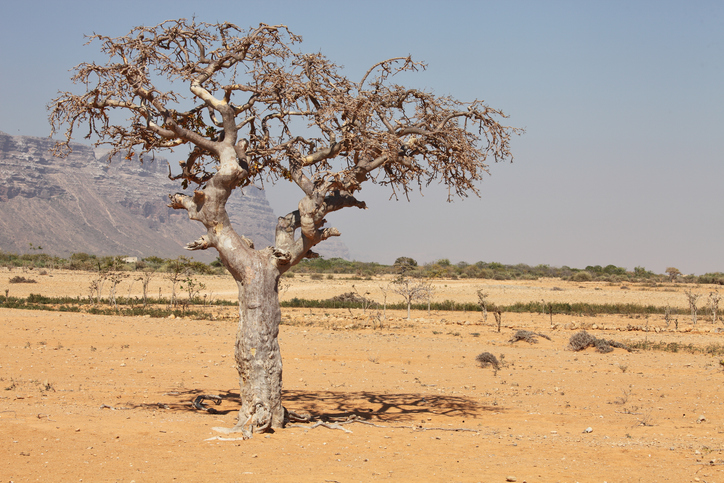
Photo by Vladimir Melnik
Somalia
Myrrh
Commiphora myrrha

Photo by Vladimir Melnik
General Description / Cultural Significance
Myrrh (Commiphora myrrha) is a spiny shrub or small tree that can grow up to 16 feet tall. Its trunk is short and thick, featuring two distinct layers of bark: a durable and dense outer layer, and a grainy, moist, and malleable inner layer. The leaves of the myrrh tree are greyish-green, papery, and oblong. In spring, the tree produces whitish-green flowers and berries that develop from them.
The bark of the myrrh tree contains a sap that dries into a resin. Harvesting this sap involves making an incision in the bark to insert a tap, similar to the method used for collecting maple syrup. Myrrh has a sharp, bitter taste and a balsamic, spicy aroma with a slight smokiness. The sap is used for various purposes, including as a disinfectant, astringent, and treatment for topical wounds such as scrapes and skin blemishes.
In Somalia, myrrh is primarily utilized as incense. The resin is highly valued for its spiritual significance and natural healing properties. Historically known as one of the three gifts brought by the Magi to the Infant Jesus, Somali folklore often suggests that the myrrh in this story was sourced from Somalia, given the country’s extensive ancient native population and cultivation of the plant. In ritual practices, myrrh is frequently burned in an enclosed space as part of a grounding ritual to prepare the body and mind for deep meditation. The rich scent of the plant is believed to anchor and envelop individuals in the present moment, creating an ideal atmosphere for personal introspection and spiritual exploration.
Climate Change / Conservation Status
In 2018, Somalia witnessed the onset of a gold rush in its northeastern mountain ranges. This rush led to the extensive clearing of trees and shrubbery to accommodate mining machinery. Among the affected vegetation, numerous myrrh trees, some believed to be thousands of years old, were clear-cut. The continued mass clearing poses a significant threat to the survival of the remaining ancient myrrh trees.
Recognizing the extreme importance of these trees, initiatives have been launched to educate gold miners about their value. This effort underscores the irony that one of the gifts historically brought to the Infant Jesus is being destroyed in the pursuit of extracting another valuable resource associated with the Magi’s offerings.
Alternate Names
Commiphora molmol
African myrrh
Turkey myrrh
Sources
“Commiphora Myrrah.” Encyclopædia Britannica, Encyclopædia Britannica, inc., www.britannica.com/plant/Commiphora-myrrah. Accessed 9 July 2024.
Flowers-Kimmerle, Nicole. “The Origin of Frankincense and Myrrh Add to Their Special Meaning.” Illinois Extension, 21 Dec. 2021, extension.illinois.edu/blogs/ilriverhort/2021-12-21-origin-frankincense-and-myrrh-add-their-special-meaning#:~:text=Myrrh%20is%20collected%20from%20a,the%20leaves%20in%20the%20spring.
Harper, Mary. “The Somali Gold Rush Endangering Frankincense and Myrrh.” BBC News, BBC, 5 Jan. 2023, www.bbc.com/news/world-africa-64162379.
“Myrrh, Commiphora Molmol Engl., Burseraceae (Frankincense Family) – Dr. Hauschka Cosmetics – Nature’s Treasures Transformed for You.” Www.Dr.Hauschka.Com – Dr. Hauschka, Dr Hauschka, www.dr.hauschka.com/en_NZ/knowledge-base/medicinal-plant-facts/myrrh/#:~:text=The%20myrrh%20we%20know%20is,berries%20ripen%20from%20the%20flowers. Accessed 9 July 2024.
“Myrrh: The Forgotten Resin with Healing Powers You Can’t Afford to Ignore.” Heritage Apothecary, 24 Feb. 2024, heritage-apothecary.com/blogs/news/the-mystical-journey-of-myrrh#:~:text=The%20act%20of%20lighting%20myrrh,for%20introspection%20and%20spiritual%20exploration.
Permanent Mission of the Somali Democratic Republic to the United Nations. This statement can be found on the World Sensorium original website.

